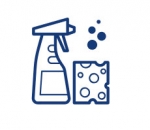Section 1: What Kills the Virus?

What Kills the Virus?

To kill germs on your hands, the Centers for Disease Control and Prevention (CDC) recommends washing hands often with soap and water for at least 20 seconds. Washing hands is more effective than hand sanitizers for removing certain kinds of germs. If soap and water are not available, using a hand sanitizer with at least 60% alcohol can help you avoid getting sick and spreading germs to others.
The CDC provides detailed instructions on washing hands and using hand sanitizer. If you have touched a surface that may have been contaminated, do not touch your face before cleaning your hands.
The Food and Drug Administration (FDA) is warning consumers about a sharp increase in hand sanitizer products that are labeled to contain ethanol (also known as ethyl alcohol), but have tested positive for methanol contamination. Methanol, or wood alcohol, is a substance that can be toxic when absorbed through the skin and can be life-threatening when ingested; an increasing number of adverse events have been reported, including blindness, heart issues, effects on the central nervous system, hospitalizations, and death.
Never ingest alcohol-based hand sanitizers; this causes alcohol poisoning and can be lethal. Hand sanitizers should be stored out of the reach of young children and should be used with adult supervision. Please note that the warnings have been expanded to include hand sanitizers that are “subpotent” and do not have a sufficient amount of ethyl alcohol, isopropyl alcohol, or benzalkonium to be effective. Also included are recalled products, as well as those found to have microbial contamination.
The FDA continually updates a list of hand sanitizers that should not be used. Hundreds of brand names have been cited, most of which are manufactured in Mexico, but a few are made in the US. Consumers need to check this list regularly and ensure the hand sanitizer products in their home (and before purchasing) are safe and effective.
To kill germs at home, most EPA-registered household disinfectants should be effective against the coronavirus; 5 tablespoons (⅓ cup) bleach per gallon of water or 4 teaspoons bleach per quart of water may also be used. Please note that household disinfectants are for household surfaces only and are not to be used on skin or ingested.
The EPA lists products that should be effective against COVID-19.
Launder washable items in water that is as hot as possible. Don’t shake dirty laundry.
Researchers are looking into how UV light can attenuate the virus. Although not as effective as social distancing measures, seasonal increases in ultraviolet radiation is correlated with a significant decrease in COVID-19 growth rates. Researchers are exploring the potential use of ultraviolet (UV) light-emitting diodes (UV-LEDs) as a fast and inexpensive agent to destroy the virus. The FDA also provides an informational Q&A about this topic.
How Long Can the Virus Live on Surfaces?

While we do not have a definitive answer at this point, studies suggest that the COVID-19 virus may behave like other coronaviruses, which linger on surfaces for a few hours, or up to many days in various environments. The CDC provides recommendations for cleaning and disinfecting different surfaces.
New research suggests that COVID-19 can live on skin for up to 9 hours. Wash hands for 20 seconds or use hand sanitizers to disinfect skin that may have come in contact with the virus.
The National Institutes of Health (NIH) says preliminary studies have found coronavirus in aerosols (droplets dispersed and suspended in the air) for up to 3 hours; up to 4 hours on copper; up to 24 hours on cardboard; and up to 2–3 days on plastic and stainless steel.
A study out of Australia’s national science agency (CSIRO) found that the virus can live on surfaces like device screens, stainless steel, and paper for up to 28 days when kept at room temperature and not exposed to UV light. UV light is known to kill the virus.
Other health experts argue that the risk of transmission via fomites (i.e., surfaces or objects) may be exaggerated because most studies have been conducted in settings that do not reflect real-life conditions. Science has not yet come to a consensus about surface transmission but that doesn’t mean there isn’t a possible risk. With a new, more contagious variant of COVID-19 currently circulating, health and safety agencies like the World Health Organization (WHO), the CDC, and the EPA continue to recommend disinfecting any surfaces you think might be contaminated.
For more information, please visit MSAA’s online collection of COVID-19 materials, “The Coronavirus and MS.”

